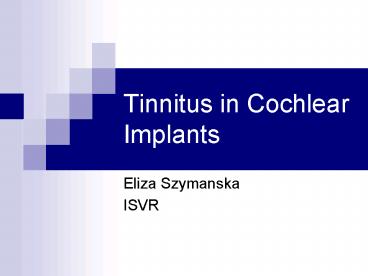Tinnitus in Cochlear Implants - PowerPoint PPT Presentation
1 / 11
Title:
Tinnitus in Cochlear Implants
Description:
... tinnitus as a result of hearing loss and damaged outer hair cells in cochlear ... Tinnitus in Cochlear Implants. Is CBT valid and effective for CI users? ... – PowerPoint PPT presentation
Number of Views:85
Avg rating:3.0/5.0
Title: Tinnitus in Cochlear Implants
1
Tinnitus in Cochlear Implants
- Eliza Szymanska
- ISVR
2
- Tinnitus is a perception of sound, it must be
heard, it is involuntary, it is not produced
intentionally and originates in head or in one or
both ears - It is usually described as ringing noise, high
pitched whining, buzzing, hissing sound
3
Prevalence of Tinnitus
- Between 10-15 of the population have tinnitus
- 3-5 of all people with tinnitus are troubled by
it - 1 of this amount reported to have severe effect
on quality of life
4
- Tinnitus is not itself a disease but a symptom
- About 80 of people who suffer from tinnitus have
also hearing loss. That is why the most common
theory about tinnitus combine tinnitus as a
result of hearing loss and damaged outer hair
cells in cochlear
5
CBT for Tinnitus patients
- CBT a psychotherapeutic approach that aims to
influence dysfunctional emotions, behaviours and
cognitions through a goal-oriented, systematic
procedure
6
- CBT involve structured interviews, daily diary
and self-report questionnaires - Treatments include applied relaxation, imagery
and distraction techniques, advice what and how
to listen, management of sleep - Cognitive restructuring of thoughts and beliefs
associated with tinnitus
7
Phd Project
- Tinnitus in Cochlear Implants
- Is CBT valid and effective for CI users?
- Do we need a new criteria in CBT for CI users?
8
Methodology
- The study consist of two interventions, one based
on questionnaires and one based on Cognitive
Behavioural Therapy in group - We need 80 participants !!
9
Questionnaires
- Tinnitus Questionnaire
- Visual Analogue Scale
- Quality of life, Short Form 36-SF36
- Hospital Anxiety and Depression Scale
- Additional open questions
10
Procedure
- 80 participants
- Set of questionnaires before and after
implantation - 4-6 participants 12 sessions of CBT in group
- Set of repeated questionnaires
- outcomes
11
How we hear
Amygdala (emotions)
Auditory cortex (interpretation, memory)
Autonomic nervous system (automatic fight or
flight responses)
Auditory brainstem (subconscious monitoring)
Auditory periphery (coding of sound) (initiation
of neural representation)































